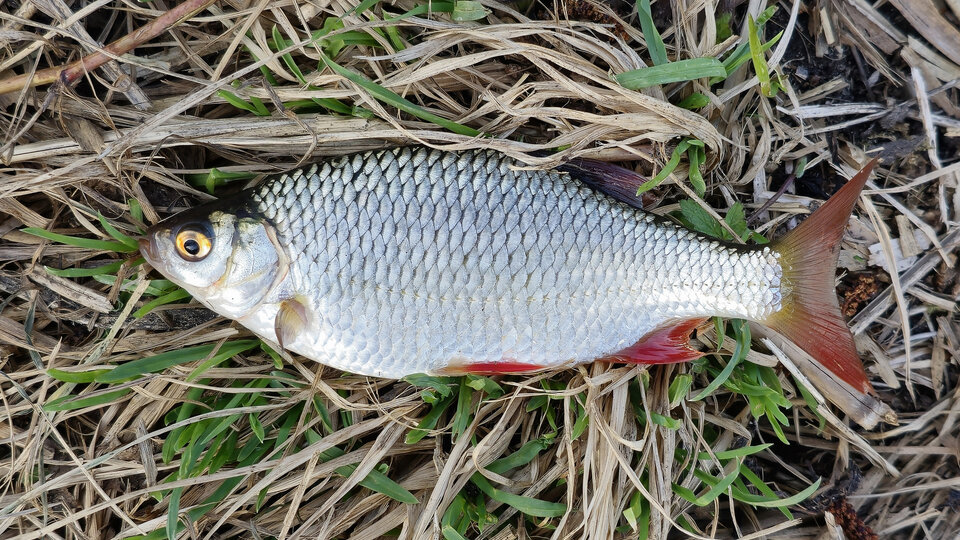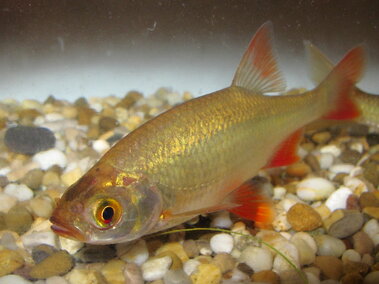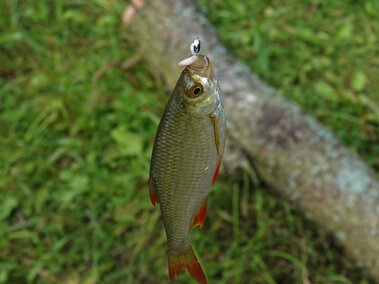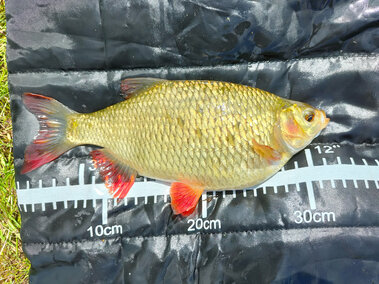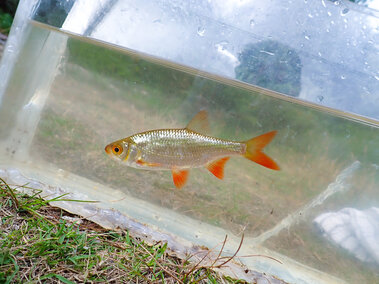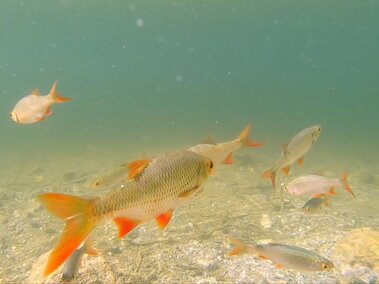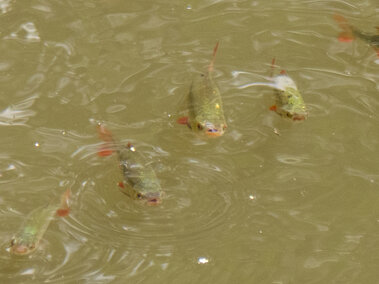General Information
Species Name: Scardinius erythrophthalmus
Also Known As: European rudd, common rudd
Family: Cyprinidae (Minnow)
Life Span: 4-17 years
Life Cycle: Reproduction occurs from April to August, typically beginning once water temperatures exceed 16°C (60°F). Adhesive eggs are laid among submerged vegetation in warmer, calmer waters near shore. Fecundity ranges from 3,500–232,000 eggs. Maturation occurs at 2 to 3 years when the fish is 90 to 150 mm (3.5”-6”) in total length.
Origin: Eurasia
Injurious: No.
Category 3: Established Aquatic Invasive Species
Why Are They Invasive?
Rudd cause recreational, economic and ecological damage to Nebraska's waters. They can outcompete native fishes for food, and their ability to switch from eating invertebrates to fish to plants make them very effective competitors. They disrupt native fish habitat through consumption of aquatic vegetation. They can increase turbidity by stirring up the sediments when feeding, resulting in a decline in water quality. They can hybridize with native golden shiner, with unknown impacts on golden shiner populations.
What Do They Look Like?
The rudd is a somewhat stocky, deep-bodied fish with a forked tail, and the mouth is distinct with a steeply angled protruding lower lip. The scales are robustly marked, the back is dark greenish-brown, and the sides are brassy yellow tapering to a whitish belly. The pectoral, pelvic, and anal fins are bright reddish-orange, and the dorsal and tail fins are reddish-brown. They have a deep, compressed body and a scaled keel along the belly between the pelvic and anal fins.
Photos
Where Do They Live?
Rudd is a bottom-dwelling fish that prefers water up to 3 meters deep and temperatures between 2°-22°C (35°-72°F). Abundance decreases with depth, and populations benefit from artificial and natural coastal refuges that help them avoid predation. They can thrive in both flowing and still water environments. Rudd has omnivorous feeding habits that can change with temperature and season. Generally, their diet includes aquatic plants and algae, while sometimes eating invertebrates and small fish. This species has been recorded as introduced to 23 US states and the Canadian province of Ontario. In a number of other states it has been used as a bait fish, but there is as yet no record of it being found in open waters. Available data indicate established populations still survive in Maine and New York, and, more recently, evidence indicates it is established in Massachusetts, Nebraska, and South Dakota.
How Do They Spread?
Rudd have been introduced through a combination of bait bucket releases, escapes from aquaculture facilities and farm ponds, and, presumably, by natural dispersal from various points of intentional introduction.
How Do I Control Them?
Management of invasive fish involving either mechanical removal or application of chemicals to public waters requires a permit. Contact the Contact the Nebraska Game and Parks Commission for more information.
CLEAN your watercraft, trailer, angling gear and other equipment. Remove all aquatic vegetation and animal species from your equipment.
DRAIN your watercraft at the ramp by removing the boat plug and draining all live wells and ballast tanks.
DRY your watercraft, trailer and other equipment for at least 7 days before visiting another waterbody.
DON'T DUMP BAIT. Dispose of bait by emptying bait buckets on dry land, away from waterbodies or in a trash receptacle. Moving a live organism from one waterbody to another is illegal, even if you are planning to use the organism as bait.
DON'T LET IT LOOSE. Do not release or transport exotic or non-native fish species to new ecosystems. It is unlawful to release any aquatic species into a waterbody other than the one from which it was harvested. Doing so can promote the spread of AIS.
What Should I Do If I See Them in Nebraska?
If you see rudd in Nebraska, you should report them to the Nebraska Game and Parks Commission's Aquatic Invasive Species (AIS) Program using their AIS Report Form. For guidance on what information to include in your report, check out our reporting tips.
References and More Information
Center for Invasive Species and Ecosystem Health
Minnesota Department of Natural Resources
Nebraska Game and Parks Commission
U.S. Fish & Wildlife Service Ecological Risk Screening Summary
